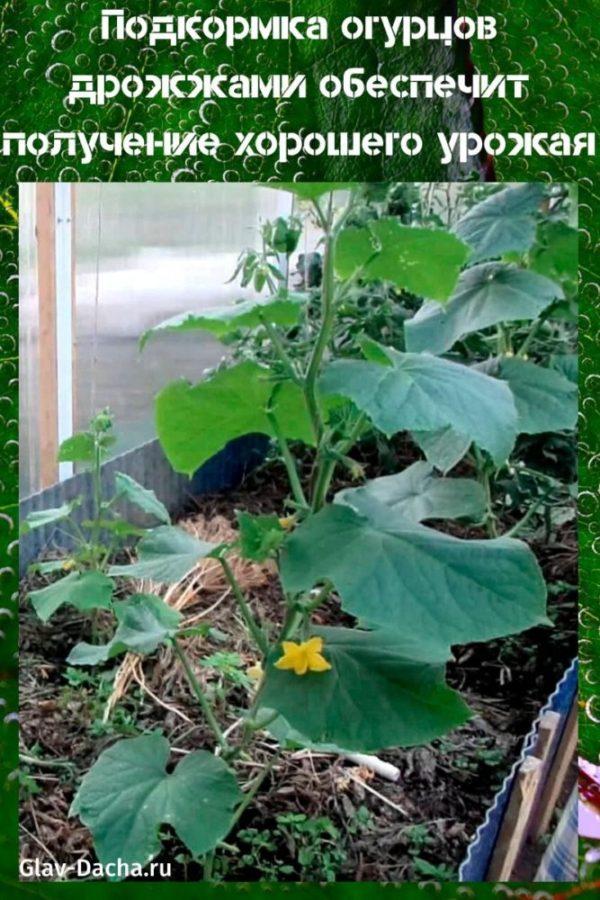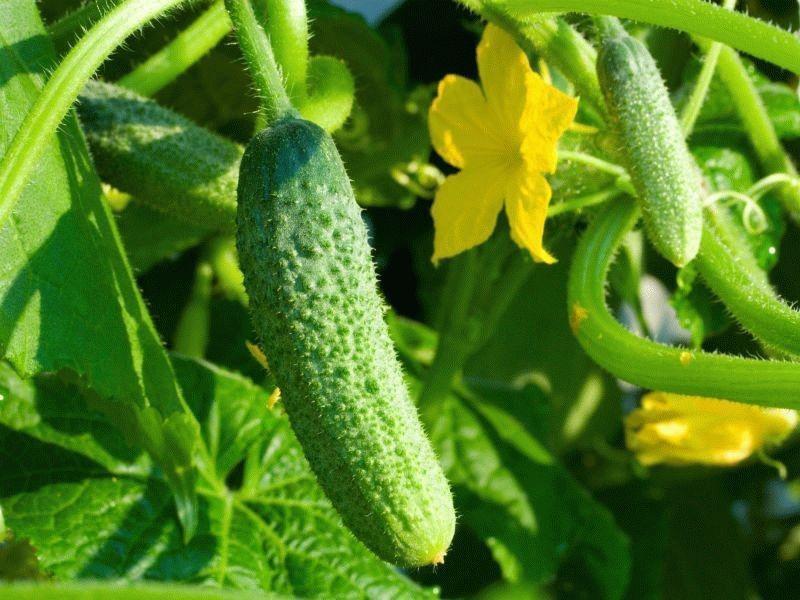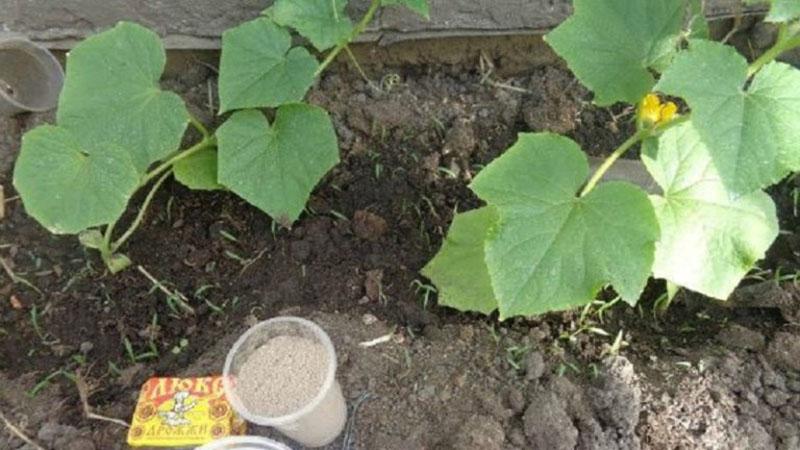Feeding cucumbers with yeast will ensure a good harvest
 Feeding cucumbers with yeast is a normal practice for lovers of self-cultivation of vegetable crops. For any gardener, a good harvest on their own plot is a source of pride. However, to grow tasty vegetables, you need to enrich the soil. Many people use growth stimulants for this, fertilizers with chemical components in the composition. But there are those who prefer to use only natural substances.
Feeding cucumbers with yeast is a normal practice for lovers of self-cultivation of vegetable crops. For any gardener, a good harvest on their own plot is a source of pride. However, to grow tasty vegetables, you need to enrich the soil. Many people use growth stimulants for this, fertilizers with chemical components in the composition. But there are those who prefer to use only natural substances.
How feeding cucumbers with yeast affects the plant

The idea of using yeast to feed cucumbers and other vegetable plants is quite justified. They consist of a huge amount of vitamins and minerals and can easily replace any fertilizer.
Yeast is composed of the following components:
- potassium;
- magnesium;
- phosphorus;
- organic iron;
- zinc;
- calcium;
- aluminum;
- nitrogen.
In addition, dry matter contains from 35 to 50% proteins and nitrogenous compounds, 35-45% carbohydrates, up to 2% fats. The rest is ash elements in the form of minerals.
 Feeding cucumbers and other vegetable crops with yeast allows plants to resist pathogenic microorganisms and insect pests, since after proper fertilization, the immunity becomes stronger. Yeast fungi, after dissolving in water and getting on the ground, become food for the beneficial bacteria that live there. They absorb acids, vitamins and minerals obtained from yeast, recycle soil organic matter and transform useful components in the most accessible form for culture.
Feeding cucumbers and other vegetable crops with yeast allows plants to resist pathogenic microorganisms and insect pests, since after proper fertilization, the immunity becomes stronger. Yeast fungi, after dissolving in water and getting on the ground, become food for the beneficial bacteria that live there. They absorb acids, vitamins and minerals obtained from yeast, recycle soil organic matter and transform useful components in the most accessible form for culture.
 It is noticed that when using yeast for cucumbers as fertilizer, adaptation occurs faster when planting seedlings in open ground. The root system develops to the full, which allows it to absorb moisture and nutrients from the soil with a vengeance, respectively, the ground part of the culture also accelerates growth.
It is noticed that when using yeast for cucumbers as fertilizer, adaptation occurs faster when planting seedlings in open ground. The root system develops to the full, which allows it to absorb moisture and nutrients from the soil with a vengeance, respectively, the ground part of the culture also accelerates growth.
Some gardeners prepare a weak yeast solution to spray green mass. This strengthens the culture's immunity and reduces the risk of disease.
Terms of feeding
 You should figure out what periods of development you can feed cucumbers with yeast. The culture is fertilized at different stages of growth, but it is especially recommended to use it during the period of planting seedlings in the soil. It is believed that feeding cucumbers with yeast is the best way to successfully acclimatize in a new place. At this time, the plant experiences severe stress from the effects of different temperatures and lighting, and with prolonged precipitation or sudden night frosts in the spring, the culture may die. Therefore, at this stage, it is important to feed it, thereby improving its resistance to the transition period.
You should figure out what periods of development you can feed cucumbers with yeast. The culture is fertilized at different stages of growth, but it is especially recommended to use it during the period of planting seedlings in the soil. It is believed that feeding cucumbers with yeast is the best way to successfully acclimatize in a new place. At this time, the plant experiences severe stress from the effects of different temperatures and lighting, and with prolonged precipitation or sudden night frosts in the spring, the culture may die. Therefore, at this stage, it is important to feed it, thereby improving its resistance to the transition period.
Basic rules for feeding cucumbers with yeast:
- the procedure should be carried out a week after moving the seedlings to the garden;

- it is necessary to wait until the air warms up to 20 ° C and above, it is impossible to use the solution in cold weather;
- the solution must be fresh - you cannot leave it until the next application;
- fertilizer must be applied at the root;
- the temperature of the solution must be at least 40 ° C, otherwise the fungi will die;
- do not recommend carrying out the procedure during extreme heat;
- on the eve of the procedure, the soil must be thoroughly moistened;
- it is necessary to make top dressing in the evening;
- weakened seedlings are fed only after the development of three leaf plates.
Fertilizing cucumbers with yeast during fruiting
 As for feeding cucumbers with yeast during fruiting, the procedure is allowed, since it contributes to the rapid formation of ovaries.
As for feeding cucumbers with yeast during fruiting, the procedure is allowed, since it contributes to the rapid formation of ovaries.
Thus, it is possible and necessary to fertilize with yeast no more than 3-4 times per season: when the seedlings are dived into separate pots, when transplanted to the beds and during the formation of ovaries. Can be processed after the first harvest. The exposure time of top dressing is 1.5-2 months, so it often makes no sense to introduce yeast.
Yeast actively multiplies while in the ground and displaces pathogenic microorganisms from it. This greatly improves the health of the vegetable area. It is noticed that after such dressings, the taste of the fruit improves.
In what cases is feeding especially necessary? Gardeners know that the plants themselves will answer this question. It is enough to watch them carefully.
Fertilization is required in the following cases:
- the stems are thin and pale;
- seedlings look lifeless and weak, developing slowly;
- green mass and whips grow slowly;
- fruits curl and turn yellow, have weak taste or are bitter;
- no ovaries (or very few of them).
Making a yeast feed for cucumbers is useful in case of depleted soil and bad weather conditions.
The most effective recipes
 Due to the rich vitamin and mineral composition of the yeast, gardeners are happy to use the solution, resulting in a good harvest. As such feeding has become popular, there are many recipes to choose from.
Due to the rich vitamin and mineral composition of the yeast, gardeners are happy to use the solution, resulting in a good harvest. As such feeding has become popular, there are many recipes to choose from.
The easiest recipe for making cucumber yeast fertilizer can be made without using other ingredients other than water. Dissolve 1 kg of fresh yeast in 1 liter of warm water. The solution must be left in a warm place for a day. After that, the agent is diluted in water in a ratio of 1:10. The resulting solution can be used to process the ground parts of the plant, as well as feed the bushes, pouring 0.5 liters under each.
The solution can also be prepared from dry yeast. Dissolve 10-15 g of dry granular yeast in a three-liter container. Then add 0.5 cups of sugar there and mix thoroughly. The solution should ferment in a warm place for a week. After that, dissolve 200 ml of fermented infusion in 10 liters of warm water and add this mixture to 1 liter under each bush.
 Yeast infusion is considered a good remedy in combination with ash... It should be prepared in several stages. Initially, you need to sift the wood ash and pour 300 g of 3 liters of boiling water. The solution should be infused for at least 10 hours. Then strain it through cheesecloth and add another 8 liters of water. Dissolve about 100 g of fresh yeast in 1 liter of warm water until the first signs of fermentation appear. Add this dough into the ash solution and mix thoroughly. Such feeding of cucumbers with yeast is equally effective both in the greenhouse and in the open field.
Yeast infusion is considered a good remedy in combination with ash... It should be prepared in several stages. Initially, you need to sift the wood ash and pour 300 g of 3 liters of boiling water. The solution should be infused for at least 10 hours. Then strain it through cheesecloth and add another 8 liters of water. Dissolve about 100 g of fresh yeast in 1 liter of warm water until the first signs of fermentation appear. Add this dough into the ash solution and mix thoroughly. Such feeding of cucumbers with yeast is equally effective both in the greenhouse and in the open field.
To prepare the solution, use only warm water. This is a prerequisite for working with yeast. The same goes for watering the plants. During this procedure, the weather must be warm - over 20 ° C, otherwise the yeast will not work.
Conclusion
 Yeast is an environmentally friendly and natural means for feeding any vegetable crops, including cucumbers. With their help, the plant absorbs nutrients in a more acceptable form for them. The result will depend on the correct application technology and proportions.
Yeast is an environmentally friendly and natural means for feeding any vegetable crops, including cucumbers. With their help, the plant absorbs nutrients in a more acceptable form for them. The result will depend on the correct application technology and proportions.